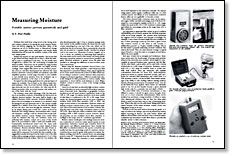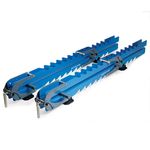
Synopsis: Problems that result from using wood at the wrong moisture content are among the most common frustrations and failures plaguing the woodworker, writes wood technologist R. Bruce Hoadley. Such woes can be avoided by using modern moisture meters, which give immediate and highly accurate readings. Hoadley details two principal types of meters for typical woodworking applications: one is based on the direct-current electrical resistance of the wood, and it involves driving pin-type electrodes into the wood; the other uses the dielectric properties of the wood and requires on surface contact of the meter with the board. He discusses the strengths and weaknesses of each.
Problems that result from using wood at the wrong moisture content continue to be among the most common frustrations and failures plaguing the woodworker. Many of the symptoms are all too familiar—warp or dimensional change in parts, opened glue joints, raised grain, end checks, finish imperfections—all because the moisture content of the stock was inappropriate.
Perhaps the excuses are also quite familiar. The job just had to get started and there simply was no time to allow the material to come to equilibrium in the shop. Or, the boards were bought from a dealer’s bin; the oven-drying of samples just wasn’t possible. Such woes can be avoided by using modern moisture meters, which give immediate and highly accurate readings. These magical little meters use the electrical properties of wood, and their development has followed the usual trend in electronics toward portable and miniature units with simplified operation. A wide range of models is now available to suit virtually every situation, from the hobbyist’s use to production operations, in the shop or in the field.
For typical woodworking applications two principal types of meters are available. One is based on the direct-current electrical resistance of the wood and involves driving small, pintype electrodes into the wood surface; the other uses the dielectric properties of the wood and requires only surface contact of the meter with the board.
The resistance meter takes advantage of the fact that moisture is an excellent conductor of electricity but dry wood is an effective electrical insulator. The meter itself is simply a specialized ohmmeter which measures electrical resistance. The piece of wood is arranged as an element in an electrical circuit by driving the two pin electrodes into it. The current (usually supplied by a battery) flows from one electrode through the wood to the other, then back through the ohmmeter. Actually, by simply driving pairs of nails into a piece of wood for electrodes and taking resistance measurements with a standard ohmmeter, readings could be obtained that would indicate relative moisture content. Perhaps some useful values could be obtained this way, but resistance varies nonuniformly with moisture content and a mass of data would have to be accumulated to make a useful and versatile meter. Commercially manufactured meters have the meter scale printed directly in percent moisture content instead of ohms of resistance. Because electricity follows the path of least resistance, the wettest layer of wood penetrated by the electrodes will be measured. For boards that dry normally, a drying gradient usually develops from the wetter core to the drier surface with an average moisture content about 1/5 or 1/4 the board thickness from the surface. Thus for 1-in. lumber, the pins should penetrate only 1/4 in. to measure average moisture content.
From Fine Woodworking #8
For the full article, download the PDF below:
Fine Woodworking Recommended Products

Ridgid R4331 Planer

Rockler Deluxe Panel Clamp

Estwing Dead-Blow Mallet






















Log in or create an account to post a comment.
Sign up Log in